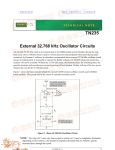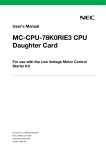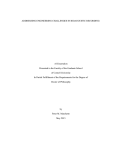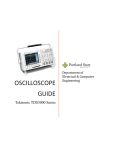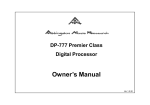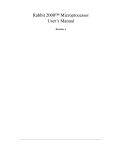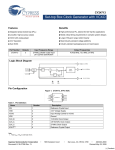Download TN235 External 32.768 kHz Oscillator Circuits
Transcript
TN235 External 32.768 kHz Oscillator Circuits An external 32.768 kHz clock is an essential part of any Rabbit-based system. Besides driving the real-time clock, the 32.768 kHz clock is used by various processor and peripheral subsystems that are used extensively by Dynamic C software. It is therefore recommended that an external 32.768 kHz oscillator circuit always be implemented. It is possible to operate the Rabbit without a 32.768 kHz clock, but several key features will not be available. Without the 32.768 kHz clock, the real-time clock, the watchdog timer, the periodic interrupt, and asynchronous remote bootstrap will not function. Neither will any of the low-power features that run off the 32.768 kHz clock. Figure 1 shows the basic concept behind the external CMOS crystal oscillator circuits used in Rabbit-based products. The crystal used in the circuit is a parallel resonant crystal. VBAT R1 Cin R1 and R2 control the power consumed by the unbuffered inverter. SN74AHC1GU04 U1A R2 U2A NC7SP14 Rp Rs CL = 5-12 pF 32.768 kHz C1 C2 C1 values may vary or C1 may be eliminated Figure 1. Basic 32.768 kHz Oscillator Circuit NOTE: The value of C1 may vary from system to system, or C1 may be completely eliminated depending on the crystal CL, the amount of frequency deviation from 32.768 kHz, and the measured drive through the crystal. 022-0084 Rev. E 1 The oscillator is constructed using low-cost single-gate logic. An unbuffered gate is used for the oscillator because buffered inverters have a tendency to oscillate at higher frequencies and are prone to startup problems. The output of the oscillator is fed to the Rabbit through a Schmitt trigger buffer. The Schmitt trigger serves two primary functions. First, it prevents power supply or high-frequency switching noise (primarily from address lines) from getting coupled into the slow rising clock signal generated by the oscillator; and second, it buffers the output of the oscillator to generate fast rising/falling (4 ns) square waves. Internal and External 32.768 kHz Oscillators The 32.768 kHz oscillator circuit implemented in Rabbit-based systems may vary depending on the Rabbit processor’s revision and version, low-power requirements, and the type of crystal used. Table 1 lists the types of crystal oscillator circuits that can be used with each type of Rabbit microprocessor. Table 1. 32.768 kHz Crystal Oscillator Circuit Types 32.768 kHz Oscillator Microprocessor Internal Internal External Schmitt Trigger Rabbit 2000, A–C Yes Yes* Yes† Rabbit 3000 No Yes No Rabbit 3000A No Yes Yes * External oscillator is used in low-power applications with battery backup. † The Schmitt trigger is part of the on-chip oscillator buffer. Note that the Rabbit 2000 family of microprocessors contain an internal 32.768 kHz oscillator. Refer to Chapter 14 of the Rabbit 2000 Microprocessors User’s Manual for more information on circuit requirements. The internal circuit does not offer the same flexibility as the external circuit for low-power operation mainly because resistors cannot be placed in series with the power or ground of the oscillator to limit the switching (crossover) current. The rest of this technical note will concentrate on external oscillator circuits. 022-0084 Rev. E 2 Rabbit-2000-Based Oscillator and Battery-Backup Circuits Figure 2 shows the external 32.768 kHz oscillator and battery-backup, and battery-switchover circuits used in Rabbit-2000-based systems. The circuits were designed for low-power operation. VBAT-EXT D1 R3 VRAM 2 kW External Battery R4 11 kW Vcc Rabbit 2000x VBAT (pin 42) D2 R5 10 kW D4 R6 22 kW C3 1 nF C4 1 nF R1 47 kW R2 0W EXT_OSC U1 Rabbit 2000x XTALA1 (pin 40) Rp 22 MW CONFORMAL COATING AREA Rs Y1 32.768 kHz C1 10 pF 330 kW C2 22 pF Figure 2. Rabbit 2000x 32.768 kHz Oscillator and Battery-Backup Circuits The current consumption of the circuit is about 4 µA with a 2 V supply. Using this circuit, oscillation continues even when the voltage drops to 0.8 V, and oscillation is still very strong at 1.2 V. Note that the internal Schmitt trigger of the Rabbit 2000 family of processors does not operate reliably at voltages below 0.9 V. Furthermore, the oscillator should have its exposed circuit traces conformally coated to prevent the possibility of loading the circuit by conduction on the PC board surface in a moist atmosphere. (Rabbit Semiconductor has published an application note on conformal coating, Technical Note TN303, Conformal Coatings.) 022-0084 Rev. E 3 Figure 3 shows the external battery-switchover circuits used in Rabbit-2000-based systems. VRAM Vcc SRAM Chip Select VRAM R11 100 kW R8* 0W D R10* /CSRAM 0W S /CS1 Q2 FDV302P G /RESET R7 22 kW R9 10 kW Q1 MMBT3904 S D Q3 FDV302P G S D G /RESET * Add resistor R8 to bypass Q2 Add resistor R10 to bypass Q3 Q4 2N7002 C5 1 nF Figure 3. Rabbit 2000x Battery-Switchover Circuit 022-0084 Rev. E 4 Rabbit-3000-Based Oscillator and Battery-Backup Circuits Figure 4 shows the external 32.768 kHz oscillator, battery-backup, and battery-switchover circuits used in Rabbit-3000-based systems found in Z-World and Rabbit Semiconductor board-level products. VBAT RTC Circuit CLK32K C3 RESOUT U2 10 nF R1 Power to VRAM Switch NC7SP14 C4 10 nF U1 FDV302P D R2 22 kW R3 47 kW Q1 Rp 22 MW Y1 CL = 7 pF C5 100 nF 32.768 kHz C1 R4 100 W R5 D1 150 kW BAT54 VRAM +3.3 V 0W SN74AHC1GU04 Rs 330 kW C2 33 pF VBAT_EXT S G RESOUT C6 10 nF C1 values may vary or C1 may be eliminated CONFORMAL COATING AREA VRAM Figure 4. 32.768 kHz Oscillator and Battery-Backup Circuit for Rabbit-3000-Based Systems The circuit in Figure 4 consumes about 8 µA for a Rabbit 3000 with U2 present and VBAT_EXT = 3.0 V. Rabbit-3000A-based systems have special power-up requirements. In these systems, the oscillator may not start oscillating when the battery is connected for the first time. The input to the internal Schmitt trigger gets stuck in a region where the Schmitt trigger is unable to latch the data high or low. Since the oscillator is not running, the output gets stuck somewhere in the linear region because of Rp. This cycle continues until some amount of random noise disrupts the stability of the system and kick-starts the oscillator. The stuck condition results in a drop in the battery voltage and an increase in current draw. For the circuit in Figure 4, the current draw measured at R8 increases to 13 µA with the majority of the current going through VBAT. This occurs because R8 is large and is used to provide current to the SRAM, oscillator, and VBAT. The Schmitt trigger requires a large amount of current at startup, and R8 limits the amount of current available to the circuit. 022-0084 Rev. E 5 This is not a problem with the circuit in Figure 4 because powering a system only at VBAT_EXT for a prolonged period doesn’t make any sense and is not normally done. If for some reason a system is only powered at VBAT_EXT (the first time) for a long period of time, the current draw will not drain the battery significantly. Once main power is applied to the system. the oscillator begins operating, and when main power is removed, the circuit will switch over to the battery and will continue to operate reliably. Note that the circuit in Figure 4 is used for low-power systems. If a Rabbit-3000A-based system is not battery-backed and the oscillator power consumption is not an issue, the circuit can be simplified as shown in Figure 5 below. C1 values may vary or C1 may be eliminated Vcc = VBAT CONFORMAL COATING AREA C3 10 nF SN74AHC1GU04 CLK32K U1 Rp 22 MW Rs Y1 C1 32.768 kHz CL = 7 pF 330 kW C2 33 pF Figure 5. 32.768 kHz Circuit for Applications not Battery-Backed For low power circuits, an alternative circuit can be designed that does not exhibit the startup issue present in the standard circuit shown in Figure 4. 022-0084 Rev. E 6 The circuit in Figure 6 provides separate supplies for the oscillator (VOSC), SRAM (VRAM), and RTC (VBAT). The circuit consumes about 6.5 µA for VBAT_EXT = 3.0 V, and oscillation starts at 1.25 V. This solution does not have the startup issue, but is more expensive primarily because of the extra PMOS transistors. +3.3 V CLK32K D RESOUT BAT54 G S CONFORMAL COATING AREA R3 VBAT_EXT 220 kW NC7SP14 VOSC C3 10 nF R1 0W +3.3 V D RESOUT G S R4 R2 22 kW VRAM Rp 22 kW 22 MW CSRAM = 10 nF Y1 CL = 7 pF +3.3 V 32.768 kHz D RESOUT G S R5 330 kW C1 Rs 330 kW C2 33 pF VBAT C1 values may vary or C1 may be eliminated C4 10 nF Figure 6. Alternative Low-Power Circuit for Rabbit-3000A-Based Systems 022-0084 Rev. E 7 Component Selection Guidelines Rp The bias resistor, Rp, biases the oscillator buffer (amplifier) to operate in the linear region (VDD/2). When biased this way, the amplifier has a high gain and will oscillate at the specified frequency. The recommended value for Rp is between 10 MΩ and 25 MΩ. As the value of Rp increases, the gain of the amplifier will also increase, enabling the oscillator to start faster and continue operating at a lower voltage. Rp also limits the short-circuit current when the CMOS gate is switching and thus the overall current consumption. It is important to note that the 32.768 kHz oscillator circuit draws a very low operating current and has a high input impedance. The circuit is thus susceptible to noise from nearby high-speed switching traces and board level contaminants such as dirt and moisture. It is therefore necessary to protect the oscillator circuit from high-speed switching signals by keeping the oscillator traces short and using guard traces and copper pours appropriately. Furthermore, the exposed circuit traces should be conformally coated to protect the circuit from environmental contaminants. Refer to technical Note TN303, Conformal Coating, for more information. Rs The purpose of Rs is to increase the output impedance of the oscillator buffer and limit its drive current. Rs also affects the amplitude of the voltage swing going into the crystal, and is thus limited by the operating voltage. The value of Rs has to be large enough to prevent the crystal from being overdriven, but not too large to kill the swing going back into the oscillator. An excessively large Rs may also cause the circuit to oscillate at an overtone other than that of the fundamental frequency. Moderate overdrive of the crystal may be acceptable. However, excessive overdrive may increase the aging of the crystal and may possibly damage the crystal. It is somewhat difficult to predict a suitable value for Rs with which to begin. As a starting point, select a value for Rs such that it has the same impedance as C2 at the operating frequency. From this point, the value can then be modified to achieve the desired drive level or voltage swing: 1 R s = -------------------------2πf osc * C2 C1, C2 For parallel resonant circuits, the phase shift/load capacitors provide the phase shift and load capacitance necessary for the oscillator to operate at the tuned frequency. The values of C1 and C2 can be modified to adjust the oscillator frequency. 022-0084 Rev. E 8 The value of the load capacitors can be calculated in the following manner. ( C1 + C in )* C2 C L = -------------------------------------- + Cs ( C1 + C in ) + C2 In the above equation, Cin represents the input capacitance of the oscillator buffer (roughly 6 to 6.5 pF), CL represents the specified load capacitance of the parallel resonant frequency crystal, and Cs represents the stray circuit capacitance, which is usually in the range of 2 to 5 pF. Note that Cin is not constant, but rather is a function of frequency—any measurements of Cin should be done using a sine wave generator operating at 32.768 kHz. Ideally C1 and C2 would have equal values because the inverter output introduces a phase shift of 180° and the combination of C1, C2, and the crystal would provide the additional 180° phase shift required for the phase shift of the loop to equal 360°. However, in reality, the inverter also introduces a phase delay, which creates a phase shift that is somewhat greater than 180°. The capacitors compensate for this phase difference by changing their impedance. This change in impedance can only occur if the circuit oscillates at a slightly higher frequency than that of the series resonant frequency of the crystal, which is about 32.765 kHz. In effect, the capacitors pull the oscillation frequency. The capacitors serve several functions. • First and foremost, they provide the appropriate load capacitance for the crystal to oscillate at the correct frequency. • The capacitors provide the correct amount of phase shift for the circuit to oscillate. Note that oscillation will not occur if the loop gain is not greater than 1 and if the loop phase shift does not add up to 360°. • The RC circuit and the input capacitance of the oscillator buffer control the swing into the buffer, and the input side capacitance also affects the crystal drive. This affects the power consumption and the maximum operating voltage. • The capacitors are used to tune the crystal frequency. This is called pullability, and is a function of the load capacitors. R1, R2 For low-power applications, these two resistors limit the power consumption of the oscillator buffer (U1 in Figure 4) by limiting the crossover current during switching. The slower the switching speed, the longer the transistors stay in the transition region, and thus the greater the crossover current. Note that the Schmitt trigger does not consume as much current because of its fast switching speed. The key to controlling the current through the oscillator buffer is to limit the amount of switching current by placing resistors in series with the power and ground of the inverter. These resistors not only limit the current, but also affect the gain of the oscillator, the startup and stop voltages, the output duty cycle, and output rise and fall times. The circuit also becomes more susceptible to noise, necessitating the use of the Schmitt trigger. The layout of the oscillator circuit is therefore extremely important when dealing with such low-current, low-gain, high-input-impedance circuits. The distances between the Rabbit processor, oscillator buffer, and Schmitt trigger must be minimized to prevent noise from getting coupled into the circuit. 022-0084 Rev. E 9 Crystal The 32.768 kHz crystal used in Rabbit-based systems is the same type of crystal as the tuning-fork quartz crystals used in wristwatches. Table 2 outlines the specifications for these 32.768 kHz crystals. Table 2. 32.768 kHz Crystal Specifications Type — Through Hole or SMD Tuning-Fork Crystal Nominal Frequency F 32.768 kHz Frequency Tolerance at +25°C df/F ± 20 ppm Load Capacitance CL 7.0–12.5 pF Series Resistance RS 50 kΩ (max.) Drive Level P 1 µW (max.) Quality Factor Q 50,000 (min.) Turnover Temperature TT + 25°C ± 5°C Parabolic Curvature Constant K -0.04 ppm/°C2 (max.) Shunt Capacitance C0 1.4 pF (typical) Capacitance Ratio C0/C1 ~400 (typical) Motional Capacitance C1 0.0035 pF (typical) Aging df/F First year: ± 3 ppm max. at +25°C Operating Temperature Range T0 -40°C to +85°C Storage Temperature Range TS -50°C to +125°C Shock df/F 5 ppm max. Vibration df/F 3 ppm max. Cut — X-Cut X-cut crystals have a parabolic temperature curve. The maximum frequency variation in tuningfork crystals is roughly -0.04 ppm/°C2. The frequency tolerance at 25°C is typically ± 20 ppm. Frequency drift per day at 85°C According to the parabolic temperature curve, the change in frequency at +85°C is -144 ppm. Since 1 day = 86400 seconds, 86400 seconds/day * (-144 ppm) = -12.44 seconds/day Frequency drift per day at -45°C According to the parabolic temperature curve, the change in frequency at -45°C is -196 ppm. 86400 seconds/day * (-196 ppm) = -16.93 seconds/day NOTE: The -0.04ppm/°C2 parabolic curvature constant is a maximum value. Actual tests of the crystal yield a drift of -140 ppm (-12.13 seconds/day) at the temperature extremes (-40°C and +85°C). 022-0084 Rev. E 10 Crystal Drive Level Typical 32.768 kHz crystals are specified for a maximum drive level of 1 µW. A modest overdrive, perhaps 100% over this limit, will most likely not have any adverse effect except to cause the crystal to age more rapidly. Aging in a crystal is exhibited as a gradual change of frequency, about 3 parts per million, and is most significant in the first few months of operation. The drive power can be computed from P = (I2)*R, where I is the rms AC current and R is the effective resistance of the crystal. Typical values for R are 25 kΩ for 32.768 kHz turning-fork crystals. Maximum values are often specified as 35 kΩ or 50 kΩ. If the effective resistance is 25 kΩ, then 1 µW of power is reached when I = 6.3 µA (rms). It is logical to use the typical effective resistance rather than the maximum total resistance in computing drive-power. If a particular crystal has a higher resistance, it requires more power to sustain the same amplitude of physical flexure of the quartz. This indicates that the stress on the quartz will not be greater even though the drive power is greater for a unit that happens to have an effective resistance of 35 kΩ rather than the typical value of 25 kΩ. In calculating the current through the crystal, the output capacitance of the buffer is not relevant because the resistor Rs isolates it from the crystal. C1, however, is very important. If C1 is made smaller, this will increase the voltage swing on the gate input of the oscillator buffer and will allow the oscillator to operate at a lower voltage. This oscillator will start at about 1.2 V and operate down to about 0.75 V. The current can be measured directly with a sensitive current probe, but it is easier to calculate the current by measuring the voltage swing at the gate input with a low-capacitance oscilloscope probe. The rms voltage at this point is related to the rms current by the relationship I = Vrms*ω*Ctot where Ctot = C1 + CIn + Cprobe ω = 2π(32768) Vrms = 0.707(Vp-p) If Ctot = 12 pF (assuming Cprobe = 1 pF) and the effective resistance is 25 kΩ, then the current in (µA) and the drive power in (µW) are given by the following approximation. I = 2.5*Vrms P = 0.1*(Vrms)2 or I = 1.75*Vp-p P = 0.05*(Vp-p)2 Based on the above equations and calculations, P = 1.25 µW for a 5.0 V (p-p) swing, P = 0.65 µW for a 3.6 V (p-p) swing, and P = 0.45 µW for a 3.0 V (p-p) swing. 022-0084 Rev. E 11 From the above analysis it is clear that the value of C1 greatly affects the crystal drive level. The value of C1 depends on the crystal load capacitance, CL. For this reason, Rabbit-based systems use crystals with low CL requirements. Currently, Rabbit-2000 and 3000-based systems use crystals with a load capacitance of 7 pF. Summary of Values for Rabbit-Based 32.768 kHz Oscillators Component Value Rp 10–25 MΩ Rs 330–680 kΩ Limits drive current (crystal-drive level ~ 1 µW) CL 6.0–12.5 pF Parallel resonant crystal load capacitance C1 0–15 pF C2 15–33 pF R1, R2 2–22 kΩ Notes Affects gain The values can be used to tune the oscillator frequency, and may vary depending on the crystal load capacitance used. Appropriate values can be determined through calculations and optimized through experimentation. Approved Manufacturers List Component Crystal Manufacturer Part Number Contact ECS ECS-0327-6-17 http://www.ecsxtal.com ILSI IL3R-HX5F7-32.768 http://www.ilsiamerica.com Seiko Instruments SSPT7-.032768-7pF http://www.siielectroniccomponents.com Texas Instruments SN74AHC1GU04DBVR http://www.ti.com Unbuffered Inverter Schmitt Trigger Fairchild Semiconductor NC7SU04M5 NC7SZU04P5 http://www.fairchildsemi.com On Semiconductor NL17SZU04DF http://www.onsemi.com/home Fairchild Semi. NC7SP14P5 http://www.fairchildsemi.com 022-0084 Rev. E 12 References Marvin E. Ferking, Crystal Oscillator Design and Temperature Compensation, Van Norstrand Reinhold Company, New York, 1978. Benjamin Parzen, Design of Crystal and other Harmonic Oscillators, John Wiley and Sons, Inc., New York, 1983. Norman L. Rogers, Rabbit Semiconductor. David Salt, HY-Q Handbook of Quartz Crystal Devices, Van Norstrand Reinhold (UK) Co. Ltd., 1987. Z-World, Inc. Rabbit Semiconductor 2900 Spafford Street Davis, California 95616-6800 USA 2932 Spafford Street Davis, California 95616-6800 USA Telephone: (530) 757-3737 Fax: (530) 757-3792 Telephone: (530) 757-8400 Fax: (530) 757-8402 www.zworld.com www.rabbitsemiconductor.com 022-0084 Rev. E 13













